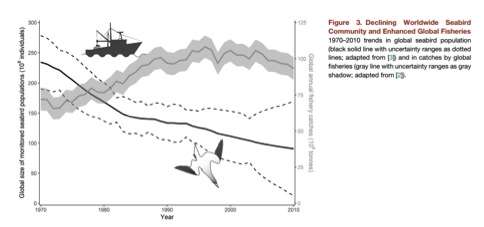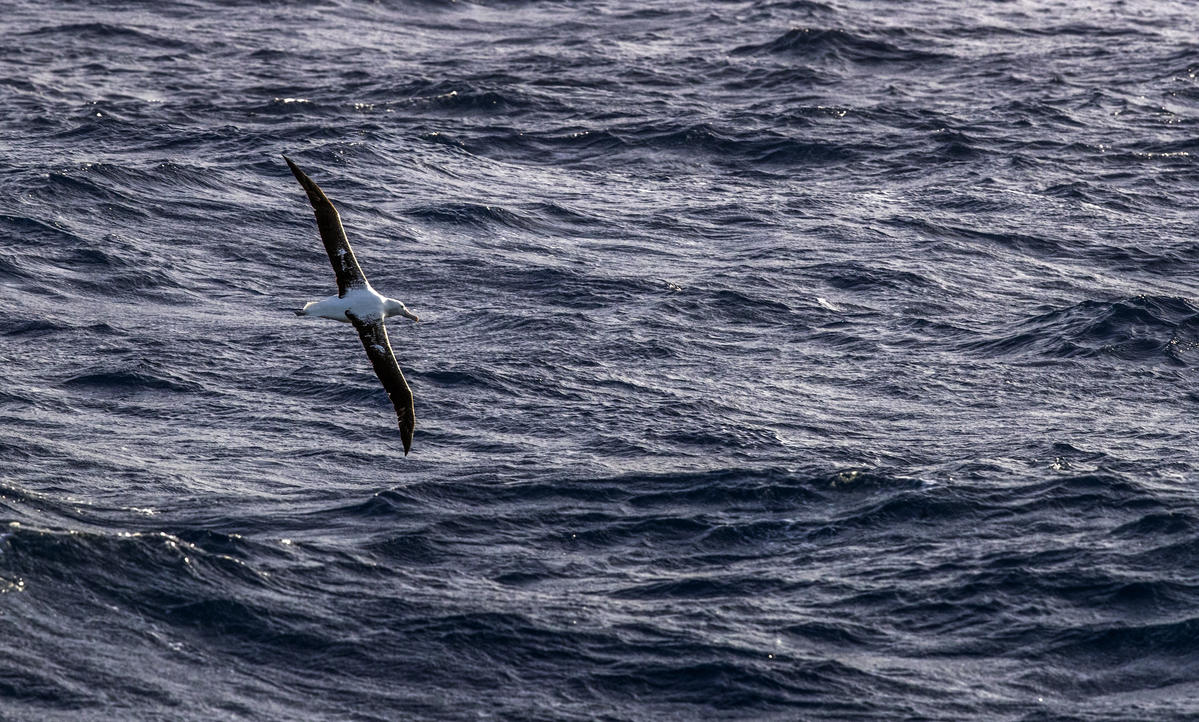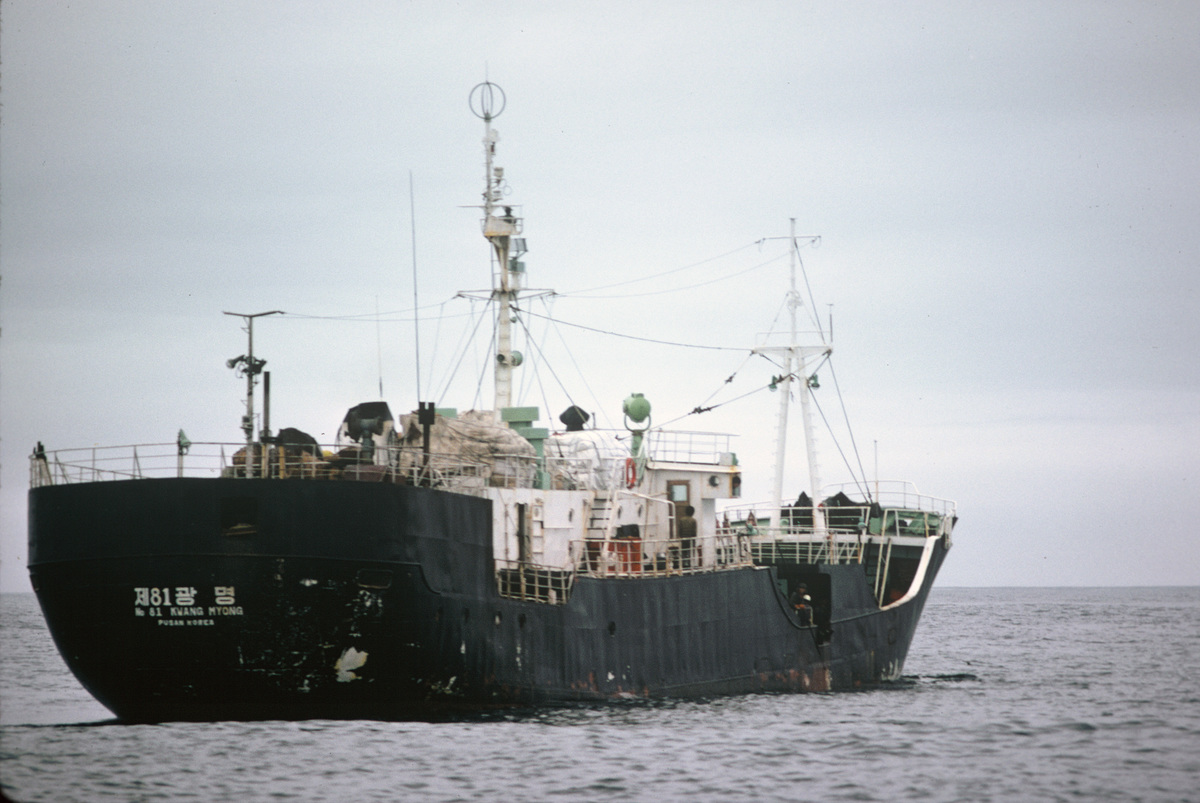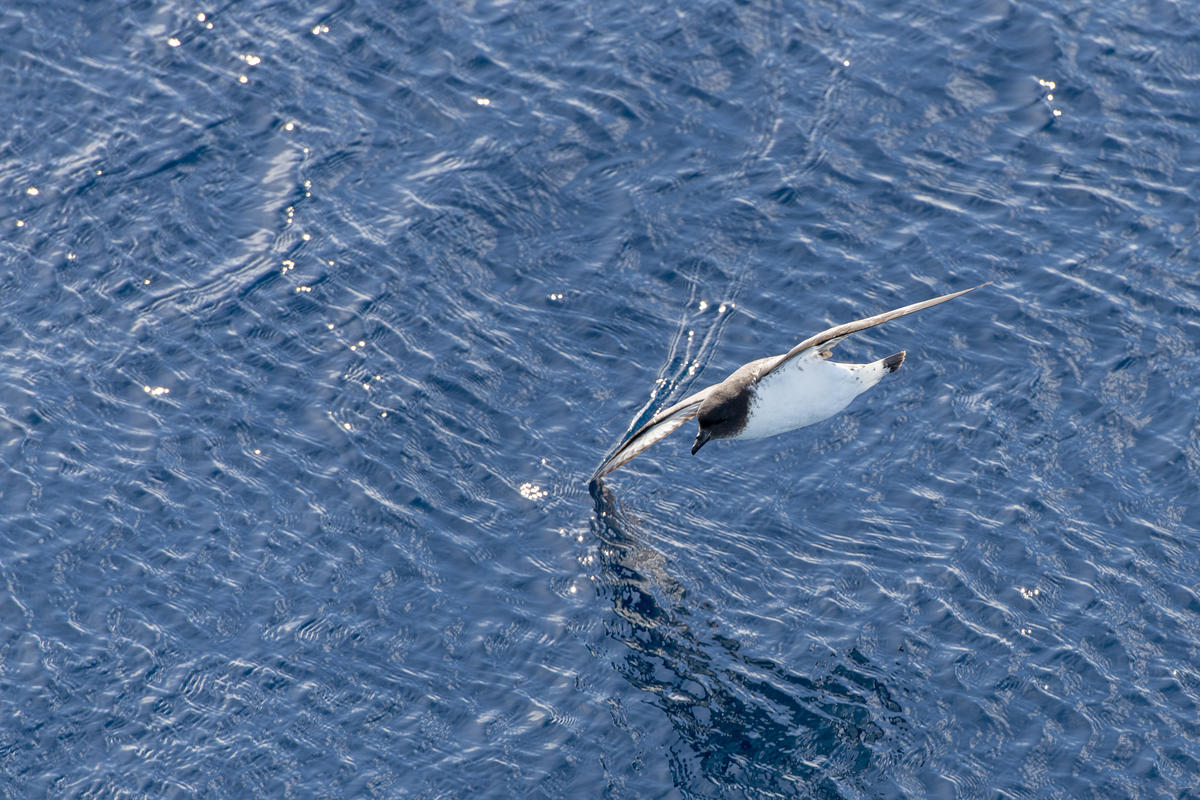international colleagues, concluded that “extinction caused by overfishing precedes all other pervasive human disturbance to coastal ecosystems, including pollution … and climate change.”
Five years later, in 2006, research by Boris Worm from Dalhousie University in Canada, and others, documented an “accelerating loss” of biodiversity in marine ecosystems as “recovery potential, stability, and water quality decreased exponentially.”

declining worldwide seabird community © David Grémillet
Concerned by these results, the Grémillet team reviewed forty years of global seabird monitoring and catch statistics for all fisheries targeting seabird prey. Their study, published in Current Biology last year, found that the global catch of seabird prey fish had increased by 10% during that period, while global seabird food consumption had decreased by 19%. They concluded that global fishing “constrains a vanishing seabird community.”
Seabird Decline
Seabirds are among the most devastated and threatened species of wild animals in the world. Furthermore, since seabirds perform critical food-web functions, their decline contributes to the destabilization of marine ecosystems worldwide.
According to a 2015 bird population trend study by Michelle Paleczny and colleagues at the University of British Columbia, in Canada, seabirds suffered a “70% community-level population decline between 1950 and 2010.” The largest declines appear among species that feed on deep-sea fish, severely reduced by industrial fishing fleets.

A Wandering Albatross (Diomedea exulans) passes by a Greenpeace ship © Paul Hilton / Greenpeace
A 2017 study by Deborah Pardo and colleagues with the British Antarctic Survey Ecosystems Programme found that three major groups — the Wandering, Black-browed, and Grey-headed albatrosses — had declined by 40–60% in 35 years. Of the 22 known species, all appear on the International Union for Conservation of Nature (IUCN) Red List, 17 “Threatened with extinction.”

A white-capped albatross and its chick. © Greenpeace / Dave Hansford
Meanwhile, plastic flotsam kills over a million seabirds per year. Global heating, ocean acidification, oil spills, and toxic chemical pollution also contribute to seabird decline.
Albatross are particularly vulnerable to longline hooks and and trawling nets. Thousands of birds get snared in “ghost nets,” virtually invisible nylon netting lost from ships, drifting throughout the oceans. We now know from the Grémillet, Paleczny and other studies, that seabirds are disappearing due to a lack of food, as industrial-scale fishing fleets over-harvest prey fish species.
The 2018 Grémillet research found that the prey species had been significantly depleted in 48% of all seabird marine habitats, particularly in the Southern Ocean, Asian shelves, Mediterranean Sea, Norwegian Sea, and along the Californian coast.
“Seabirds are particularly good indicators of the health of marine ecosystems,” says Michelle Paleczny in her seabird population study. “When we see this magnitude of seabird decline, we can see there is something wrong with marine ecosystems.” Furthermore, the loss of seabirds becomes a system feedback that “causes a variety of impacts in coastal and marine ecosystems.” Seabirds, for example, transport nutrients in their waste from the deep sea, back to the coastal ecosystems in which they breed, helping to fertilize entire food webs.
State of the Oceans
Over-fishing is only one of many human impacts on the oceans, along with plastic, oil, and chemical pollution. Perhaps the most pervasive human impact comes from our carbon dioxide emissions.
Since the 1970s, the world’s oceans have absorbed over 30% of the carbon dioxide from the burning of oil, coal, and gas. When water (H2O) reacts chemically with carbon dioxide (CO2), the process leaves an abundance of positive hydrogen ions (H+), the criterion of acidity, measured on the pH scale. Since the beginning of the industrial revolution in the 18th century, the average ocean pH has dropped from approximately 8.25 to less than 8.1, representing a 30% increase in acidity. The pH acid/base scale, like the Richter scale for measuring earthquakes, is logarithmic, so drop of only 0.1 pH units represents a 25% increase in acidity. If human society continues to burn petroleum as a primary energy source, the world’s seawater pH could drop to 7.7 by 2100, creating an ocean more acidic than any seen since the Miocene heating, around 14 million years ago, long before hominids emerged in Africa, and when global temperatures had reached about 3°C warmer than today.

Danish scientist, Signe Klavsen, investigating ocean acidification. © Nick Cobbing / Greenpeace
Acidic water inhibits shell formation among clams, oysters, mussels, urchins and starfish, contributing to the decline of some species. The shells of tiny forminifera zooplankton
begin to dissolve in the more acid sea water. A study by Sven Uthicke and others at the Australian Institute of Marine Science has predicted that tropical foraminifera — and entire class of amoeboid protists critical to the marine food web — will be extinct by the end of the century. Researchers have observed that the shells of pteropods, free-swimming sea snails, are already dissolving in the more acidic water of the Southern Oceans.
Ocean acidification also changes the pH of some fishes’ blood, a chemical reaction called acidosis. A small pH change can make a large difference in health and survival. In humans, a blood pH drop of 0.2 can cause seizures and even death.
Ocean dead zones, along populated coast lines, are primarily caused by fertilizer runoff and fossil-fuel use. Algal blooms, augmented by the nutrient increase, create hypoxic, oxygen-depleted waters that kill other marine life. According to the 2017 “World Scientists’ Warning to Humanity,” these coastal dead zones have increased by 75% since the 1960s, with more than 600 coastal ecosystems affected.

Korean dragger operating off the coast of California. 1975 © Greenpeace / Rex Weyler
Jellyfish, which have more resistance to pH changes are already beginning to dominate some marine ecosystems, disrupting the food web by competing with fish for declining zooplankton, thereby effecting the prey of seabirds.
As we should know well enough by now: when human activity touches anything within a complex ecosystem, those actions necessarily affect the entire web of life that binds that ecosystem together.
Positive efforts
The picture emerging from these studies has inspired interest in marine reserves and protected areas. For seabird populations to recover, this political work needs to expand.
In 2017, Chile stopped the massive Dominga open-pit copper and iron mining project near Coquimbo, to safeguard the Humboldt Penguin Marine Reserve, located off the coast. The reserve supports the rare Humboldt penguin, blue whales, humpback and sperm whales, bottlenose dolphins, sea turtles, sea lions, albatross, and many species of fish.
In 2011, Belize permanently banned trawling in all its waters, the third nation to do so, partially to protect the Belize Barrier Reef System. Venezuela and Palau have also banned trawling completely. Large areas in the US, Indonesia, Philippines and other Pacific islands are closed to trawling. Under president Obama, the US banned bottom trawling in a 23,000 square mile area off the Southeast Atlantic coast and reinstated a ban on offshore drilling in the eastern Gulf of Mexico and the Atlantic coast. Morocco and Turkey recently banned illegal drift-net fishing.

A Cape Petrel © Daniel Beltrá / Greenpeace
However, 2016 paper by Avigdor Abelson in BioScience, concludes that “current practices are insufficient to reverse ecosystem declines.” The Ableson study shows that restoration ecology must become an integral part of marine conservation efforts. The Worm research showed that active restoration of marine biodiversity could increase ocean productivity fourfold. There remains an urgent need for increased international seabird and marine conservation effort internationally.
==========
Resources and Links:
“Persisting Worldwide Seabird-Fishery Competition Despite Seabird Community Decline,” David Grémillet et al., Current Biology, v. 28, # 24, Dec. 17, 2018
“Historical overfishing and the recent collapse of coastal ecosystems,” Jackson, J.B., et al., Science 293, 629–637, pdf, 2001.
“Impacts of biodiversity loss on ocean ecosystem services,” Worm, B., et al. Science 314, 787–790. pdf , 2006.
“Starving seabirds: unprofitable foraging and its fitness consequences in Cape gannets competing with fisheries in the Benguela upwelling ecosystem,” David Grémillet, et al.; Marine Biology, 2016.

No comments:
Post a Comment
Note: Only a member of this blog may post a comment.